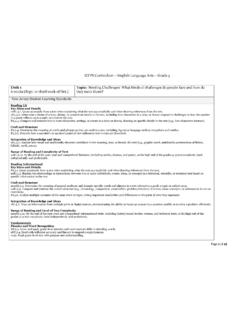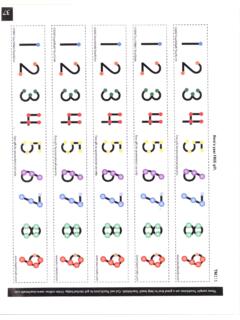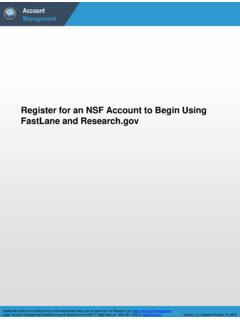Transcription of Using Microsoft® Excel to Enhance Teaching and Learning
1 MISSOURI research & EDUCATION NETWORK 1 Using Microsoft Excel to Enhance Teaching and LearningeMINTS enhancing Missouri s Instructional Networked Teaching Strategies Participant Excel XP MISSOURI research & EDUCATION NETWORK 2 Enhancing Missouri s Instructional Networked Teaching Strategies Using Microsoft Excel to Enhance Teaching and Learning MOREnet Missouri research & Education Network 3212 LeMone Industrial Boulevard Columbia, Missouri 65201 Voice: (573) 884-7200 Fax: (573) 884-6673 Cover Photos: Brian Kratzer Contributors: Janice Friesen Jennifer Kuehnle Julie Szaj Written: October 2001 Revised: September 2003 2001 Missouri Department of Elementary and Secondary Education (DESE), Missouri research and Education Network (MOREnet) and The Curators of the University of Missouri.
2 Materials may be duplicated or reproduced in hard-copy format for use by educators and educational institutions. The copies may be used for noncommercial purposes only. Titles or names of specific software discussed or described in this document are registered trademarks, trademarked or copyrighted as property of the companies that produce the software. Please note that the World Wide Web is volatile and constantly changing. The URLs provided in the following references were accurate as of the date of this report, but we can make no guarantees for their permanence. MISSOURI research & EDUCATION NETWORK 3 Table of Contents Purpose of the Module ..4 Module What is a Spreadsheet? ..5 Workbooks and Worksheets ..6 Cells ..6 Formatting Cells ..7 Graphing.
3 7 Using Printing ..12 Spreadsheets in the Classroom ..12 Classroom Activities ..13 Practice ..16 Advanced Tips and Tricks Using Raw Data ..16 Putting a Title on the Changing the Width of More Than One Column at a Changing the Format of Numbers ..18 Extending the M&M Inserting a Spreadsheet or Chart into Another Application ..19 Putting Spreadsheets on the Using the $ in a Formula ..21 Formula Shortcuts ..21 MISSOURI research & EDUCATION NETWORK 4 Purpose of the Module The purpose of this module is to give teachers experience Using Microsoft Excel . After Learning the basic skills involved, teachers can find ways to make this program a valuable resource for students as they collect, record, represent and analyze data from any source.
4 This module includes example spreadsheets from classroom teachers. Module Objectives Learners will create a simple spreadsheet to analyze data. Learners will make charts and diagrams to represent mathematical data. Learners will use simple formulas in a spreadsheet. Learners will become aware of many uses for spreadsheets in an inquiry-based classroom. Learners will plan a way to use this program with their students in the next month. MISSOURI research & EDUCATION NETWORK 5 What is a Spreadsheet? A computer user can collect, organize and analyze data in a spreadsheet program. Teachers can use it to record attendance and homework assignments and to calculate grades. Students can use the program to improve their research and analytical skills while they work on studies and reports.
5 Excel opens with a grid of boxes where data can be entered. Each space in the grid is a cell and each cell is designated by a letter and a number. The letter indicates the column location and the number indicates the row position. Excel has highlighted one cell in black and highlighted the letter above that cell and the number to its left. These coordinates indicate that the name of that cell is (A, 1).Task Pane The task pane can be opened or closed. It gives shortcuts for many tasks. MISSOURI research & EDUCATION NETWORK 6 Excel XP opens with a task pane on the right side of the screen. This window has links to most basic Excel tasks. Select the triangle at the top right side of the task pane to reveal a list of several other tasks. The task pane gives users the option to select a specific spreadsheet already saved in a folder.
6 To start a new document, users may choose from a listing of templates. To close the task pane and have a full screen showing just the current grid page, click the X at the top right-hand corner. To retrieve the task pane, go to the View button on the top toolbar. Select the Toolbars option and click Task pane. Workbooks and Worksheets Open a new document in Excel to see several tabs for Sheet 1, Sheet 2 and Sheet 3 at the bottom of the screen. Excel opens to a workbook that is like a grade book with different pages of grades. A workbook in Excel is one file. When a user enters or saves data anywhere in the workbook it all stays in the same file. However, one workbook can have many sheets. Sheets can have different information or they can be related to each other.
7 For example, an average on Sheet 1 can be inserted automatically into Sheet 3 so any change made on Sheet 1 will also change Sheet 3. Cells Students opening a spreadsheet may be confused by cell names. As previously explained, each cell is designated by a number and a letter. Students can have fun Learning how to use a grid by creating pictures Using the coordinates of each cell. Use a spreadsheet s cells to draw a letter or recognizable pattern. Click in a cell and set the background color in the Format menu (Format > Cells > Pattern). See the letter H in the example at right. Have students open Excel or give them a blank paper copy of a spreadsheet. Call out a cell (C, 6 for example) and have the students color in the cell (or format the background) and play BINGO.
8 Students can create pictures of their own and write out the coordinates of each cell to be filled. By exchanging papers, students get the chance both to write the coordinates and create a picture from coordinates. MISSOURI research & EDUCATION NETWORK 7 Formatting Cells In Excel , a user can change the font, background color, size, alignment and text wrap in a cell. Choose Format > Cells then choose a tab to make changes. Number Allows contents of the cell to be written in percentages or currency. Provides the option of Using decimal points. Alignment Sets the angle of the text in the cell. Sets the spreadsheet to wrap the text, shrink the text to fit or merge several cells. (Highlight cells before opening this window to merge them). Font-Sets the font size, style and color.
9 Patterns Changes the background color of highlighted cells. Shading headings or parts of a chart often makes it more readable. Graphing To really get a handle on Using Excel , make an information graph. To familiarize students with the Excel program, pass out packages of candy such as jellybeans or M&Ms and have students count, record and graph their candies by color. 1. Instruct students to enter the names of the colors in column A (see example). MISSOURI research & EDUCATION NETWORK 8 2. Have them count and enter the number of each color in column B. 3. Highlight the desired information. In this example, do not highlight the title (A1-H1). For instructions on how to insert a title, see Advanced Tips and Tricks. 4. Click on the Graph icon in the Formatting toolbar.
10 5. Let the Chart Wizard direct the four steps for making a graph. 6. Browse the types of graphs for viewing the spreadsheet. Learning the functions of all the graphs can be challenging. The most commonly used are the bar and column graphs and the pie chart. 7. View the spreadsheet as a bar graph. 8. Click Next and the program will ask if the series is in rows or columns. Try both to decide which is best for the information presented. For this project it probably makes more sense to choose rows. MISSOURI research & EDUCATION NETWORK 9 9. Choose how the graph will look. the Titles tab, type in a title for the chart and names for each axis. on Axes to choose not to name the axes. the Gridlines tab to determine how many lines appear in the final graph.













